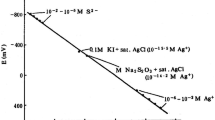Summary
Antimony microelectrodes were calibrated at 37° C in phosphate buffers, in different bicarbonate solutions at various CO2-partial pressures and in buffers like TRIS, TES, MES and malonic acid. By use of the latter buffers (with exception of malonic acid) the most reliable calibration curves were obtained (“normal values”). The usual calibration in 67 mmol/l standard phosphate buffers turned out to be unacceptable bacause the obtained mV-values were too high (negative) in comparison to all other buffers. Different calibration curves resulted from the use of pure bicarbonate solutions whether the pH-values were changed by variation ofpCO2 or of the bicarbonate concentration. Low bicarbonate concentrations in combination with lowpCO2 gave mV-values which were too low relative to the other buffers. Both the increase ofpCO2 as well as of the bicarbonate concentration caused a shift of the potential of the antimony electrodes toward “normal values”. In solutions containing other buffers the influence of bicarbonate andpCO2 became negligible with increasing buffer concentration.
Decreasing oxygen partial pressure was found to cause an increase of the potential of the antimony electrodes.
The influence of liquid junction potentials at the reference electrode is discussed.
Similar content being viewed by others
References
Carter, N. W.: The production and testing of double barreled pH glass microelectrodes for measurements of intratubular pH. Yale J. Biol. Med.45, 349–355 (1972)
Green, R., Giebisch, G.: Some problems with the antimony microelectrode. In: Ion selective microelectrodes (H. J. Berman and N. S. Herbert, eds.), pp. 43–53. New York: Plenum Press 1974
Henderson, P.: Zur Thermodynamik der Flüssigkeitsketten. Z. physik. Chem.59, 118 (1907)
Ives, D. J. G., Janz, G. J.: Reference electrodes, theory and practice, p. 336. New York: Academic Press 1961
Karlmark, B.: An ultramicro method for the separate titration of hydrogen and ammonium ions. Pflügers Arch.323, 361–365 (1971)
Karlmark, B.: Net acid excretion from the proximal tubule. Acta Univ. Upsaliensis 127 (1972).
Karlmark B., Danielson, B. G.: Titratable acid,PCO2 bicarbonate and ammonium ions along the rat proximal tubule. Acta Physiol. scand.91, 243–258 (1974)
Karlmark, B., Sohtell, M.: The determination of bicarbonate in nanoliter samples. Analyt. Biochem.53, 1–11 (1973)
Kauko, Y., Knappsberg, L.: Über die Antimonelektrode. Z. Elektrochem.45, 760–769 (1939)
Küchler, G.: Zur Frage der Übertragungseigenschaften von Glasmikroelektroden bei der intrazellulären Membranpotentialmessung. Pflügers Arch. ges. Physiol.280, 210–223 (1964)
Kunau, R. T.: The influence of the carbonic anhydrase inhibitor benzolamide (Cl-11.366), on the reabsorption of chloride, sodium, and bicarbonate in the proximal tubule of the rat. J. clin. Invest.51, 294 (1972)
Landolt-Börnstein: Zahlenwerte und Funktionen aus Physik, Chemie, Astronomie, Geophysik und Technik, Bd. 2/7, S. 257. Berlin-Göttingen-Heidelberg: Springer 1960
Maas, A. H. J., van Heijst, A. N. P., Visser, B. F.: The determination of the true equilibrium constant (\(\overline {{\text{pK}}} _{{\text{1g}}} \)) and the practical equilibrium coefficient (pKlg) for the first ionization of carbonic acid in solutions of sodium bicarbonate, cerebrospinal fluid, plasma and serum at 25° and 38°. Clin. chim. Acta33, 325–343 (1971)
Malnic, G., De Mello Aires, M.: Kinetic study of bicarbonate reabsorption in proximal tubule of the rat. Amer. J. Physiol.220, 1759–1767 (1971)
Malnic, G., Vieira, F. L.: The antimony microelectrode in kidney micropuncture. Yale J. Biol. Med.45, 356–367 (1972)
Malnic, G., de Mello Aires, M., Giebisch, G.: Micropuncture study of renal tubular hydrogen ion transport in the rat. Amer. J. Physiol.222, 147–158 (1972)
Malnic, M., De Mello Aires, M., Cassola, A. C.: Kinetic analysis of renal tubular acidification by antimony microelectrodes. In: Ion selective microelectrodes (H. J. Berman and N. C. Herbert, eds.), pp. 89–108. New York: Plenum Press 1974
Mello Aires, M., Malnic, G.: Peritubular pH andpCO2 in renal tubular acidification. Amer. J. Physiol.228, 1766–1774 (1975)
Puschett, J. B., Zurbach, P. E.: Re-evaluation of microelectrode methodology for the in vitro determination of pH and bicarbonate concentration. Kidney Int.6, 81–91 (1974)
Quehenberger, P., Silbernagl, S., Deetjen, P.: pH-Stabilität verschiedener Puffer bei kontinuierlicher Perfusion proximaler Tubuli. Nieren- u. Hochdruckkr.3, 280 (1974)
Stock, J. T., Purdy, W.C., Garcia, L. M.: The antimony-antimony oxide electrode. Chem. Rev.58, 611 (1958)
Vieira, F. L., Malnic, G.: Hydrogen ion secretion by rat renal cortical tubules as studied by an antimony miroelectrode. Amer. J. Physiol.214, 710–718 (1968)
Author information
Authors and Affiliations
Rights and permissions
About this article
Cite this article
Quehenberger, P., David, S. The influence of carbon dioxide, bicarbonate and other buffers on the potential of antimony microelectrodes. Pflugers Arch. 368, 141–147 (1977). https://doi.org/10.1007/BF01063467
Received:
Issue Date:
DOI: https://doi.org/10.1007/BF01063467




